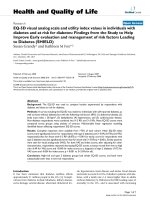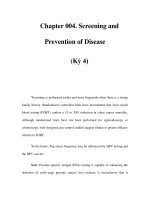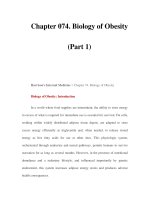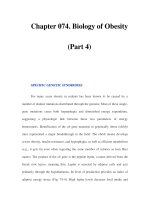Chapter 075. Evaluation and Management of Obesity (Part 7) ppsx
Bạn đang xem bản rút gọn của tài liệu. Xem và tải ngay bản đầy đủ của tài liệu tại đây (12.17 KB, 5 trang )
Chapter 075. Evaluation and
Management of Obesity
(Part 7)
The three restrictive-malabsorptive bypass procedures combine the
elements of gastric restriction and selective malabsorption. These procedures
include Roux-en-Y gastric bypass (RYGB), biliopancreatic diversion (BPD), and
biliopancreatic diversion with duodenal switch (BPDDS) (Fig. 75-2). RYGB is the
most commonly performed and accepted bypass procedure. It may be performed
with an open incision or laparoscopically.
Although no recent randomized controlled trials compare weight loss after
surgical and nonsurgical interventions, data from meta-analyses and large
databases, primarily obtained from observational studies, suggest that bariatric
surgery is the most effective weight-loss therapy for those with clinically severe
obesity. These procedures generally produce a 30–35% average total body weight
loss that is maintained in nearly 60% of patients at 5 years. In general, mean
weight loss is greater after the combined restrictive-malabsorptive procedures
compared to the restrictive procedures. An abundance of data supports the positive
impact of bariatric surgery on obesity-related morbid conditions, including
diabetes mellitus, hypertension, obstructive sleep apnea, dyslipidemia, and
nonalcoholic fatty liver disease.
Surgical mortality from bariatric surgery is generally <1% but varies with
the procedure, patient's age and comorbid conditions, and experience of the
surgical team. The most common surgical complications include stomal stenosis
or marginal ulcers (occurring in 5–15% of patients) that present as prolonged
nausea and vomiting after eating or inability to advance the diet to solid foods.
These complications are typically treated by endoscopic balloon dilatation
and acid suppression therapy, respectively. For patients who undergo LASGB,
there are no intestinal absorptive abnormalities other than mechanical reduction in
gastric size and outflow.
Therefore, selective deficiencies occur uncommonly unless eating habits
become unbalanced. In contrast, the restrictive-malabsorptive procedures increase
risk for micronutrient deficiencies of vitamin B
12
, iron, folate, calcium, and
vitamin D. Patients with restrictive-malabsorptive procedures require lifelong
supplementation with these micronutrients.
Further Readings
Bray GA, Greenway FL: Pharmacologic treatment of the overweight
patient. Pharmacol Rev 59:151, 2007 [PMID: 17540905]
Bray GA, Ryan DH: Drug treatment of the overweight patient.
Gastroenterology 132(6):2239, 2007 [PMID: 17498515]
Buchwald H et al: Bariatric surgery: A systematic review and meta-
analysis. JAMA 292:1724, 2004 [PMID: 15479938]
DeMaria EJ: Bariatric surgery for morbid obesity. N Engl J Med 356:2176,
2007 [PMID: 17522401]
Haslam DW, James WPT: Obesity. Lancet 366:1197
, 2005 [PMID:
16198769]
Kushner RF: Roadmaps for clinical practice: Case studies in disease
prevention and health promotion—
assessment and management of adult obesity:
A primer for physicians. Chicago, American Medical Association, 2003.
(Available online at www.ama-assn.org/ama/pub/category/10931.html)
McTigue KM et al: Screening and interventions for obesity in ad
ults:
Summary of the evidence for the U.S. Preventive Services Task Force. Ann Intern
Med 139:933, 2003. (Appendix tables available at www.annals.org)
National Heart, Lung,
and Blood Institute, North American Association for
the Study of Obesity: Practical guide: Identification, evaluation, and treatment of
overweight and obesity in adults. Bethesda, MD, National Institutes of Health pub
number 00-4084, Oct. 2000. Available o
nline:
Padwal R et al: Long-term pharmacotherap
y for overweight and obesity: A
systematic review and meta-
analysis of randomized controlled trials. Int J Obesity
27:1437, 2003 [PMID: 12975638]
Wadden TA et al: Lifestyle modification for the management of obesity.
Gastroenterology 132(6):2226, 2007 [PMID: 17498514]









